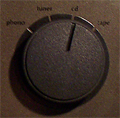
the mouse that roared
The Naim Nait2 is a belter of an integrated amp: a low powered amplifier that not only delivers the music in a coherent way that defies its cost and appearance - and many more expensive competitors - but also manages to sound more dynamic than its low (18W-ish) output suggests. It can be criticised as not having some of the sophistication (e.g. "tonal colour", whatever that is...) of its competitors, but most Nait owners are too busy having fun playing records to care.
For those who want more of the same, and are not afraid to meddle internally here is today's recipe, which has so far fed and delighted three. It's a lot less prescriptive than other mods on this site only because if you aren't reasonably sure what you are about inside an amplifier, this isn't the place to start. Although the Nait is fairly simple in construction, it does require some attention to dissemble and reassemble successfully.
Bear in mind none of this will transform the amp into something it cannot be; in fact that would be to miss the point entirely. This is about building on the Nait's strengths and just fleshing out the rest.
The first step is to replace the line stage voltage regulator with something a little better. The Nait is very simple compared to most. There is no internal wiring or opamps to worry about, no input buffers and the gain stage and the phono stage are jointly powered from a single regulated supply.
1: There is an LM317 which supplies both channels and the phono boards, in a tiny T092 package which looks like a transistor. A better 3-terminal regulator, such as a LT1086 or LM317T, is a straightforward drop-in replacement and a moderate improvement. If you stay with the LM317 supply at least change the 47uF rail decoupling caps for Oscons.
1a Supplanting the section with one of Andy's Super-regulators however is quite a revelation. Note the raw preamp supply is about 23v so the SR board needs to be set to produce about 17.2-17.5v output in order to have sufficient voltage headroom.
1b If you are not going to use the phono input (or have a separate phono stage) lift the two 27ohm resistors that feed power to the phono stage onboard. Parts are circled in blue here. It reduces demands on the regulator, and stops a certain level of grunge cross-pollinating.
1c Replace the 47uF Roederstein caps in the line stage feedback loop with something better. Elna Silmic are stunning in this application. Use 47uf/50v parts - do NOT increase the capacitance. Parts are circled in red here.
2 Power amp The big 'win' here is to add power supply capacitance connected directy between the power transistor and the main PSU 0v star point. This is recommended even if the main PSU caps have been recently replaced, and makes an utterly unsubtle improvement in the Nait's ability to drive speakers with authority , and to its 'rounder' attributes - soundstage, colour and transparency (ok, we lied, we do know what 'tonal colour' is...). Do it, do it now: we used 8no. 470uf/50v low-ESR types in 4 pairs. The experimental layout is pictured here. The new caps connect to those transistor legs at rail voltage. Verify the pins and check polarity very carefully before committing to solder! Use parts rated for a minimum of 50v.
Note that there is no interaction between pairs of caps sharing a return to the main 0v star point - this is a ClassB amp, so only one half of the output stage conducts (and needs decoupling) at a time under load. The links should be fairly heavy wire - I used 1mm solid copper.
2a Replace the 47uF/16v Tantalum caps in the feedback loop with something better. Elna Silmic are again recommended; as with the gain stage, use 47uf/50v parts and do not increase the capacitance value. Parts circled in yellow here.
2c Whilst in the area check the output stage bias current. This can be assessed by measuring the voltage drop across one of the 0.22ohm emitter resistors. Based on measuring 3 naits this should be in the in range that gives 4.7mV -7.0mV across either of the 0.22ohm emitter resistors. If each channel is within this range leave well alone. Setting bias should be done with the aid of a signal generator/distortion meter for lowest THD, but as first approximation this range of bias works well if your Nait falls outside the range indicated, or you have to set it up after replacing blown output transistors.
There is plenty of technical information available on the web regarding optimal bias for a Class B amp with complimentary output transistors if you are curious as to the 'why' of all this. Note that if you decide to turn the bias up, going for the illusion of Class A operation (as has been suggested on internet DIY sites for many other amplifiers) you deserve whatever happens; none of it will be good.
June 07 update: Optimal bias for the Nait is explored here: Naim, NAPs, bias and distortion 4.5-7.5mV is spot-on!
That wraps up our little mods list, but there are several further avenues that have been suggested by others we have not yet tried, but make good sense:
Please let us know how things turn out if you try any or all of the above.
© the twisted pair 2004